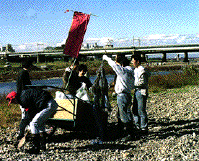 Science & Technology || Search || Back Numbers GETTING OUT OF THE CLASSROOM:
 Students' environmental education is more than just books and lectures. (Photo: Kyodo) Japanese school curriculums are giving more weight to environmental education these days. A growing number of schools are trying to teach students about the environment by taking them out of the classroom to participate in hands-on projects such as cleaning up trash in the community or monitoring the quality of the water in nearby rivers. And many schools are having students participate in environmental preservation or energy-saving efforts in cooperation with local citizens' groups. To support hands-on learning of this kind, the Environment Agency has established the Kodomo (kids') Eco-Club, a network that allows elementary- and middle-school students around the country to discuss and address environmental issues with their peers. Learning by Participating in Society One elementary school in the city of Yokohama has been devoting special efforts to environmental education for the past two years. These days, the school no longer confines environmental topics to science and social studies classes--the traditional venues for environmental education--but introduces these issues into other classes as well. For example, students studying graphs in math class might start by collecting trash from around the school and counting the numbers of cans, bottles, and paper items. They would then learn how to express this data in different types of graphs such as percentage graphs, pie charts, and bar graphs. Sometimes the school invites citizens' groups to join in these efforts. Students have gone with members of a local "save the rivers" society to measure the quality of the water at a nearby river. They have also invited a group concerned with preserving tropical rain forests to the school to help them survey the trees growing in their schoolyard. As one teacher who is guiding the students in these efforts explains, "The object is not only to foster concern for the environment, but also to bring up citizens who are capable of taking action to protect the environment." At the end of May, the Japanese Society of Environmental Education held a conference in Yokohama. Nearly 200 case studies of environmental education efforts were presented at the conference. Many of these efforts emphasized hands-on learning. For example, one elementary school in Shiga Prefecture launched an "expedition" to a waste-water drainage area to study waterquality and the problem of litter. A group of college students in Iwate Prefecture hosts a "forest survey" event that gives local children the opportunity to count trees and observe their growth. In June of this year, environmental preservation groups and teachers in Tokyo's Toshima Ward founded a private organization whose mission is to support environmental education by promoting the exchange of information among schools, companies, and citizens. Their efforts led to the opening of an environmental education information center in Toshima Ward in June of this year. The center tries to provide concrete advice to adults who are working on the front lines of the environmental preservation movement. A Nationwide Environmental Network for Kids One fourth-grade class in Higashi-Nada Ward in the city of Kobe formed a Kodomo Eco Club group after witnessing the power of nature during the Great Hanshin Earthquake (January 17, 1995). Since then, the group has begun creating what it calls a "biotope"--a habitat for a variety of living things--at the school. The students create more greenery in the schoolyard by planting the seeds from the tangerines they get in their school lunches. They spend time observing dragonflies at a pond they have dug themselves. By participating in their natural surroundings in this way, the students are learning firsthand the importance of all living things. Another Kodomo Eco Club group was formed by four third-grade girls and the mother of one of the girls in the city of Nagano, Nagano Prefecture. This group focuses on the environmental impact of the meals they eat every day. Kitchen waste such as daikon leaves and apple skins are composted or fed to the school rabbit. One of the group's activities is cooking meals that generate no garbage. Kodomo Eco Club members report their activities in a club newsletter or at meetings. And major newspapers, which are also supporting Eco Club activities, sometimes carry stories of the children's efforts. The children get inspiration and energy from one another and work together, contributing to the further expansion of the Eco Club network. "Hands-On" Movement Mirrors General Trend in Education Practical environmental education, which can be translated immediately into action, has also come to be viewed with increasing importance because the children of today will be responsible for leading the society of the future. This trend toward hands-on environmental studies mirrors a general current in educational reform that favors experiential and interdisciplinary learning. Many elementary and middle schools are moving in this direction by actively incorporating the Kodomo Eco Club into their curricula. Environmental studies, which can encompass a wide range of classroom subjects, including moral education, will most likely carry more and more weight in school curriculums hereafter.  Edited by Japan Echo Inc. based on domestic Japanese news sources. Articles
presented here are offered for reference purposes and do not necessarily
represent the policy or views of the Japanese Government.
Edited by Japan Echo Inc. based on domestic Japanese news sources. Articles
presented here are offered for reference purposes and do not necessarily
represent the policy or views of the Japanese Government.
|
